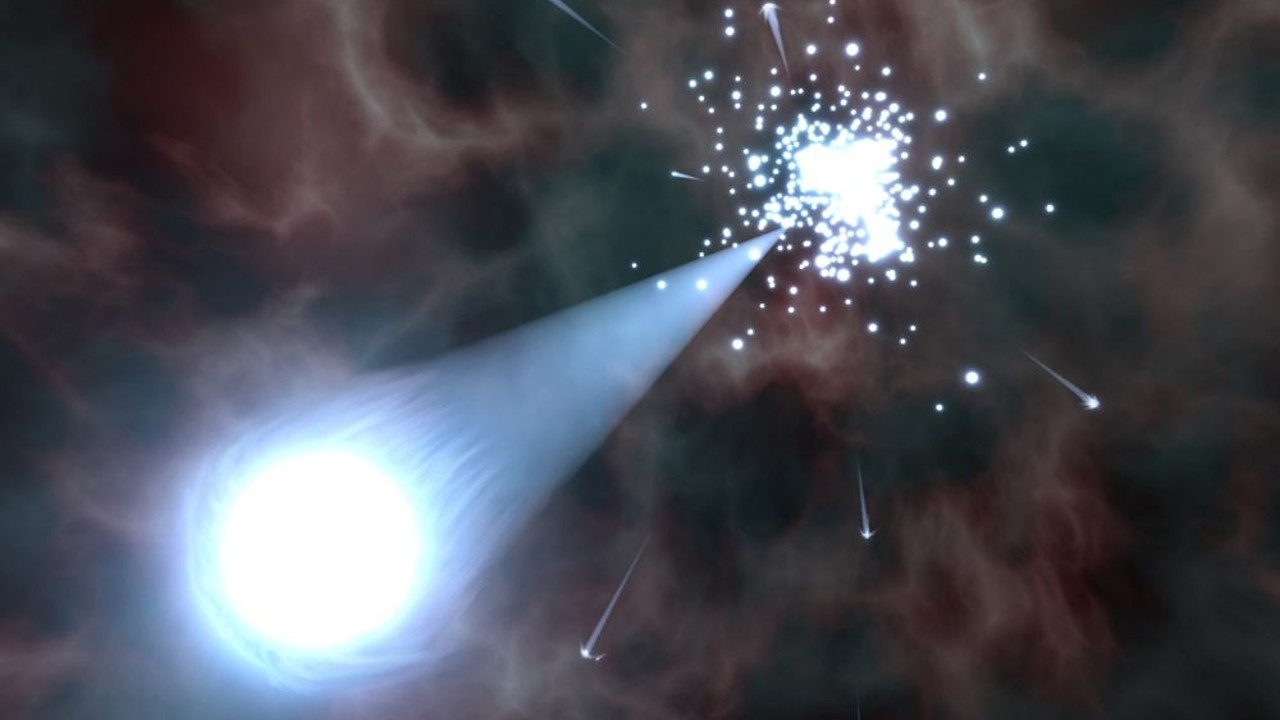Breakthrough study identifies many massive runaway stars in the Milky Way
- The study introduces a new method to discover massive and young runaway stars, which escape at great speed from their neighbours
- The research team identified 175 runaway stars, 89 of which are new discoveries
- The study was fully developed by IEEC researchers at the Institute of Cosmos Sciences (ICCUB), and is published in Astronomy & Astrophysics

Caption: Artist impression of a massive runway star being ejected from a dense star cluster.
Credits: Tomohide Wada/Four-Dimensional Digital Universe Project (4D2U), NAOJ/Science/AAAS)
A significant population of stars in the Milky Way is running away from their neighbours. A ground-breaking study carried out by researchers from the Institute of Space Studies of Catalonia (IEEC — Institut d’Estudis Espacials de Catalunya) at the Institute of Cosmos Sciences of the University of Barcelona (ICCUB) has identified a considerable number of these ‘runaway stars’, as astronomers call them, in our galaxy. The paper reveals new insights into the dynamics of massive stars and their intriguing behaviours.
The research, led by Mar Carretero-Castrillo, IEEC predoctoral researcher at the ICCUB, was published last week in Astronomy & Astrophysics, and introduces a novel method to uncover massive and young runaway stars—moving with a high velocity with respect to their surrounding stars. The study focused on the stars present in the Galactic O-Star Catalogue (GOSC) and Be Star Spectra (BeSS) catalogues—hot, massive and young stars—, and utilisedastrometric measurements from the third data release of the Gaia mission of the European Space Agency (ESA).
The team identified 106 runaway O stars, with 42 new discoveries, and 69 runaway Be stars, 47 of which are also new discoveries. Runaway stars exhibited on average a large distance from the Galactic plane, which is indicative of past ejections. Also, seven X-ray binaries and one gamma-ray binary, showing high-energy emission, were found among the runaway stars. This could strengthen the idea that a fraction of runaways can be part of the population of high-energy sources.
“The identification of so many massive runaway stars opens the door to discover new interesting astrophysical sources. We have released the catalogues of the runaway stars found in open format to the scientific community to maximise the exploitation of the potential discoveries,” explains Carretero-Castrillo.
Massive young stars play a crucial role in various astrophysical phenomena, from gamma-ray bursts to supernova explosions. In the present study, over 25% of O stars and 5% of Be stars are found to be runaway stars, with O stars showing larger velocities. Massive runaway stars can be produced by dynamical ejection in star clusters or by supernova explosions in binary systems. The study favours the former based on the observed percentages and velocities.
In addition, the study’s comprehensive simulations suggest that the percentages of runaway O and Be stars could be even higher than observed. The findings open avenues for identifying more and new runaway stars in our galaxy, and also sets the stage for further investigations into high-energy systems associated with runaway stars.
Press release prepared in collaboration with the Institute of Cosmos Sciences (ICCUB).
More information
This research is presented in a paper entitled “Galactic runaway O and Be stars found using Gaia DR3”, by Mar Carretero-Castrillo, Marc Ribó and Josep M. Paredes, which appeared in the journal Astronomy & Astrophysics on 30 November 2023.
Contacts
IEEC Communication Office
Barcelona, Spain
E-mail: comunicacio@ieec.cat
Lead Researcher at the IEEC
Barcelona, Spain
Mar Carretero Castrillo
Institute of Space Studies of Catalonia (IEEC)
Institute of Cosmos Sciences (ICCUB)
E-mail: carretero@ieec.cat
About the IEEC
The Institute of Space Studies of Catalonia (IEEC — Institut d’Estudis Espacials de Catalunya) promotes and coordinates space research and technology development in Catalonia for the benefit of society. IEEC fosters collaborations both locally and worldwide and is an efficient agent of knowledge, innovation and technology transfer. As a result of more than 25 years of high-quality research, done in collaboration with major international organisations, IEEC ranks among the best international research centres, focusing on areas such as: astrophysics, cosmology, planetary science, and Earth Observation. IEEC’s engineering division develops instrumentation for ground- and space-based projects, and has extensive experience in working with private or public organisations from the aerospace and other innovation sectors.
The IEEC is a non-profit public sector foundation that was established in February 1996. It has a Board of Trustees composed of the Generalitat de Catalunya, Universitat de Barcelona (UB), Universitat Autònoma de Barcelona (UAB), Universitat Politècnica de Catalunya · BarcelonaTech (UPC), and the Spanish Research Council (CSIC). The IEEC is also a CERCA centre.
